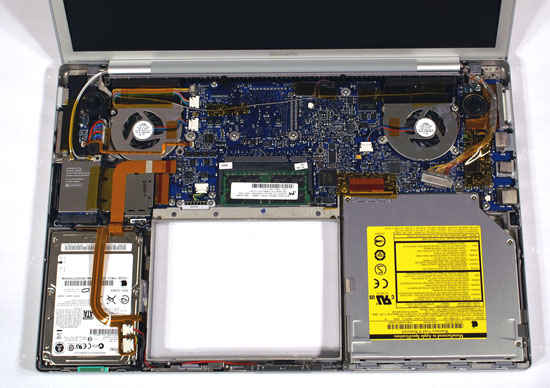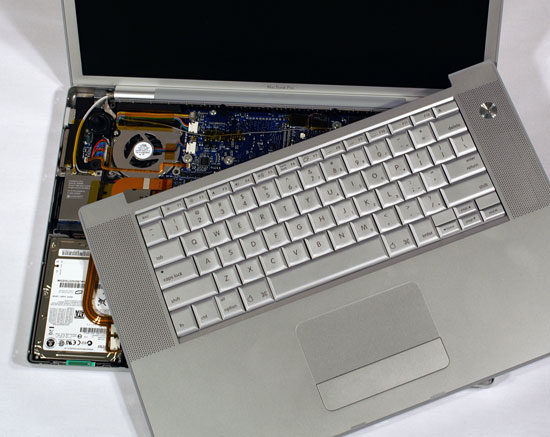Apple's MacBook Pro: Using it as a Mac and a PC
by Anand Lal Shimpi on April 13, 2006 12:00 AM EST- Posted in
- Mac
There are very few configurable options on the MacBook Pro, and the GPU is not one of them. The only GPU Apple offers is the ATI Mobility Radeon X1600; you do however have the ability to choose whether you want 128MB or 256MB of GDDR3 memory. The Mobility Radeon X1600 is a PCI Express GPU, which means that it has a high bandwidth data path to the 945 North Bridge and thus main memory. It sounds good for marketing, but with 128MB or 256MB of local memory the high bandwidth link with system memory isn't all that important.
The old 1280 x 854 panel from my 15" PowerBook G4 has been slightly upgraded to a 1440 x 900 panel. The vertical resolution hasn't been increased much at all but the increase in horizontal resolution is definitely noticeable and appreciated. Although the previous 15" was a good balance between portability and productivity, the 15" MacBook Pro improves on the balance even more thanks to its slightly higher resolution panel. I will say that the uniformity of the brightness of the panel doesn't seem to be as good as on my previous PowerBook; the panel does seem to get darker around the corners than the old panel. Obviously at different resolutions the two aren't necessarily comparable, but I wouldn't call the new panel a huge step forward. It's not bad by any means, but the brightness uniformity was one of the first things I noticed about it.
Just like its predecessor, the MacBook Pro features an integrated DVI output port, while also coming with a DVI-to-VGA dongle if you're connecting your notebook to a VGA display. An improvement over its predecessor is that its DVI output is dual link, meaning it can drive Apple's 30" Cinema Display and Dell's 3007WFP at their native resolution of 2560 x 1600.
The integrated 56K modem is finally gone from the old PowerBook's chassis, although Apple offers an optional USB modem if you absolutely need one.

The MacBook Pro's very tiny motherboard (Click to Enlarge)
For hard drives you can choose between 80GB and 120GB drives, all spinning at 5400RPM, with a single 100GB offering at 7200RPM as an option for added performance. At present, the largest laptop hard drives anywhere are only 160GB, so there's not much incentive to upgrade today. However, if you'd like to upgrade to a bigger hard drive down the road, it's not too difficult to do. Opening the MacBook Pro simply requires a small phillips head screwdriver and a T6 driver; remove all the screws along the outside and underneath the unit and you'll be able to lift out the keyboard.

Beneath the keyboard you'll see the hard drive, which after some careful disconnecting of cables can be removed.











52 Comments
View All Comments
boinkle - Thursday, April 13, 2006 - link
Great review, apart from making me think "that's still quite pretty!", at the end of the day it's just a PC in an Apple enclosure. It's shiny, fast, but has all the problems of an Apple 1st gen product, with few of the benefits of Core duo showing up...How I wish someone had given Freescale some incentive to develop the G4 further (to a reasonablt timescale). It's amazing that it's still even *reasonably* competitive. Imagine dual-core, 65nm G4 derivative production? Don't TI have a 65nm fab up and running now? That's where your 5 hours would come from, Anand... pie in the sky, I know.
*sigh*
littlebitstrouds - Thursday, April 13, 2006 - link
How about some gaming benchmarks. If you run windows and game are you getting good performance numbers? If I could have a Mac for everyday use and boot up windows when I want to game I might jump on this.Visual - Thursday, April 13, 2006 - link
you have some borked page 18 after the "final thoughts" page showing up in the dropdown.in printarticle.aspx it shows up as a duplicate of page 17 for some reason
as to the article itself - good job :)
my guess as to why the vm is faster than the real thing is because the hdd emulation works somewhat like a ramdrive - its a file on the apple hdd but it probably gets cached up by osx or by the vmsoftware itself.
plinden - Thursday, April 13, 2006 - link
That could be - I have maxed out at 2GB RAM in my iMac, and I get wired RAM is close to the max and a hefty number of Page Outs (up to 210,000 last time I looked. before it setayed below 5000 even after being on for a week) while running Parallels VM.
ibisbowti - Thursday, April 13, 2006 - link
I been using the 1.83 Core Duo for about a week now. I think it is one of the latest builds according to the serial number. No problems at all, other than it does get pretty warm. Heat issue seems better after latest firmware update. I think the aluminum is designed to be a big heat sink! I thought the Front Row software would be a little gimmicky, but it is pretty cool, especially when sitting the unit on a coffee table and watching the HD movie trailers, IPhoto pics, etc with others. It's an awesome machine so far.artifex - Thursday, April 13, 2006 - link
Since you say you ran the same tests as in your earlier review, I'd like to see graphs comparing the results of the Intel iMac vs. the MBP. and add in ones for the Intel Mini, if you can. I suspect we'll see iMac > MBP > Mini, but it would be nice to be sure.Also, if you could slap Parallels on the Mini and tell us how much of a hit the virtualization takes because the hardware virtualization is disabled for that line, that would be really interesting.
Thanks.
AppaYipYip - Thursday, April 13, 2006 - link
"Apple quality control at it's best"That comment bothers me. Overall, there are no other manufacturers that come even close to Apples quality, design, and workmanship. Yet, you find one key that sits slightly off and suddenly feel the need to make such a blanket statement. If it bothers you so much, take it back and Apple will repair it for you, in record time.
Calin - Thursday, April 13, 2006 - link
The IBM thinkpads (before the Lenovo deal) were regarded as the best business laptops (or at least PC laptops) as quality and workmanship. Too bad they were designed with cramped keyboards (at least the models I saw) and no trackpad.Ryan Norton - Thursday, April 13, 2006 - link
I'm a PC guy but I like Macs a lot and will probably buy a Macbook Pro, either now or when Merom ones come out. I figure Anand probably is too. Yet I work with Mac zealots who give me endless shit about the unequivocal superiority of Apple everything over PC (except for games, which they concede). So when someone like me finds a glaring flaw that seems like something that should have been spotted before it got to the end user, it's easy to take a cheap shot at Jobs =^)Sunrise089 - Thursday, April 13, 2006 - link
If I had my dream review of this product, here's how I would have you test gaming performance:Test performance in Windows mode. Then compare it to other Core Duo notebooks. Then see if there is any game written natively for OS-X under Core Duo, and run the OS-X version and the Windows version to see the difference in OS on performance on the same machine.
Other than no gaming info, terrific review.